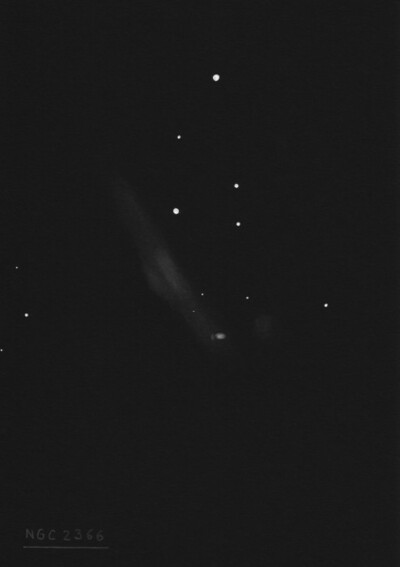
William Herschel discovered NGC 2366 = H III-748 on 3 Dec 1788 (sweep 889) and called it "vF, vS, stellar. 300 confirmed it and showed a vF branch to the nf." His description and position matches the prominent HII region at the southwest end of the galaxy. The "vf branch nf" refers to the actual galaxy. So, NGC 2366 applies to the HII region (also known as Mrk 71) as well as the galaxy. Modern sources misidentify the large HII knot as NGC 2363. See historical comments for NGC 2363.
Ralph Copeland described it on 9 Mar 1874 with the 72" as a "diffused neby preceding, pos 265.9°, dist 71.4" Neb * or neb knot post 318°, dist 77.6". The object has a curved tail, pos 30.9°, convex on the following side, traced 9' or 10'. The neb knot preceding is connected with the principal enbulosity. Line of stars spp, curved towards preceding side, nebulous? At least the enbula appears to extend so far on spp side. [See Pl I.]."
300/350mm - 13.1" (1/11/86): fairly faint, very large, elongated 5:2 SW-NE, low almost even surface brightness. An unusually bright HII region is at the SW end of the galaxy (2' from the center) and appears as a "fuzzy" 12th magnitude star. Although very small, it appeared elongated SW-NE and similar to a poorly resolved double star. Definite contrast gain with OIII filter.
400/500mm - 18" (3/19/04): at the SW end of the galaxy is a very bright knot (HII region), roughly mag 12.5 and perhaps 15" in size which responds to a UHC filter at 160x! At 323x this knot is irregular in shape (~20"x15", SW-NE) and brightness and at moments resolves into two or three components. The galaxy itself is fairly faint, large, and very elongated SSW-NNE, 3.5'x1.0', with a low surface brightness.
900/1200mm - 48" (4/15/10): The most striking feature of NGC 2366 is a prominent double knot (giant HII/starburst complex) at the SW end (also known as Mrk 71 amd NGC 2366-I). At 330x, the knot appeared very bright, elongated 3:2 E-W, ~18"x12", with two overlapping components (super star clusters A and B). A fainter and smaller knot (NGC 2366-II) was easily visible 15" E, for a total of 3 HII knots.
NGC 2363, a low surface brightness companion or detached OB association/HII region, lies 1.2' W of the bright double knot. At 330x it appeared fairly faint, moderately large, elongated 2:1 or 5:2 SW-NE, with a low but irregular surface brightness.
Notes by Steve Gottlieb